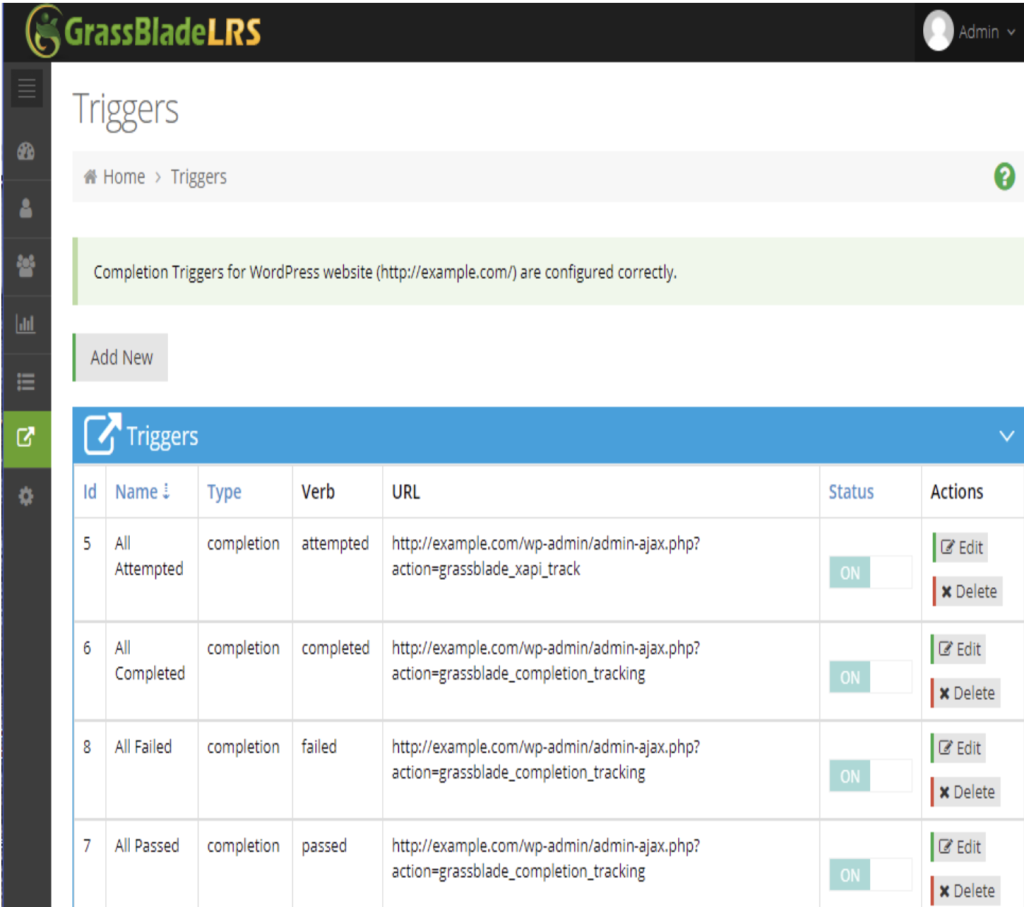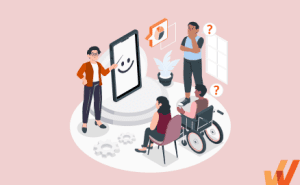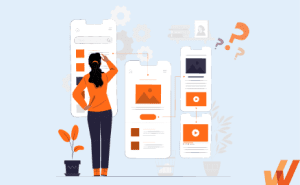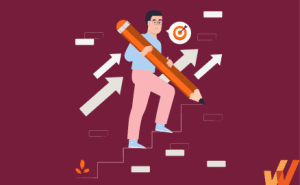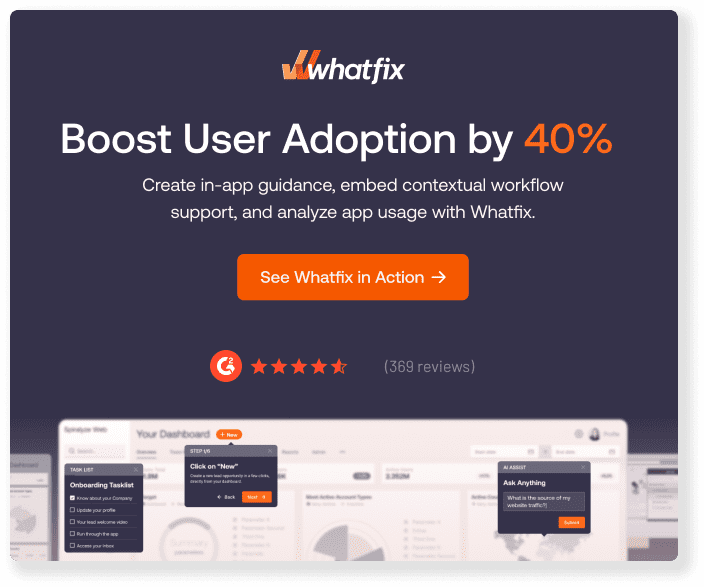Learning and development teams are constantly seeking innovative ways to enhance their employees’ learning experiences, making them more engaging, personalized, and impactful. Traditional systems often fail to capture the complete picture of how employees learn, especially when much happens outside formal training environments. This is where a Learning Record Store (LRS) comes in.
An LRS empowers L&D teams to collect and analyze data from all learning activities—whether they occur through eLearning, on-the-job experiences, or collaborative discussions. By leveraging this data, organizations can uncover insights into learner behaviors, identify gaps, and craft tailored learning journeys.
The result? A more dynamic, data-driven approach to learning boosts engagement and drives measurable outcomes for both employees and the organization.
In this article, we will learn about Learning Record Store in depth, including its benefits, software, features, and much more.
What is a Learning Record Store (LRS)?
A Learning Record Store (LRS) is a specialized system designed to collect, store, and manage data about learning experiences from various sources. It works with the Experience API (xAPI) standard to capture data from diverse learning activities, such as eLearning courses, on-the-job training, simulations, and informal learning.
What Does an LRS Enable?
A Learning Record Store expands traditional learning systems’ capabilities, allowing organizations to track and analyze learning in innovative ways. Here’s what an LRS facilitates:
- Comprehensive data tracking: An LRS collects learning-based event data from various sources, including eLearning platforms, simulations, mobile apps, and informal learning activities, providing a holistic view of learning.
- Support for informal and experiential learning: Unlike an LMS, which primarily tracks formal training, an LRS captures data from informal and on-the-job learning, offering a broader understanding of workforce development.
- Detailed compliance tracking: An LRS ensures compliance by securely storing and managing records of learning activities, certifications, and training histories for audit and reporting purposes.
How Does LRS Work with xAPI?
An LRS works hand-in-hand with the Experience API (xAPI), a learning technology standard designed to capture data about various learning experiences. xAPI enables learning activities to be recorded as statements in the format “Actor – Verb – Object.” For example, a statement could read: “Jane completed the Compliance Training Module.”
These statements are generated by xAPI-enabled learning tools, applications, or platforms and are then sent to the LRS for storage.

Once the data is collected, the LRS organizes it and makes it available for analysis. It can store data from multiple sources—eLearning courses, simulations, mobile apps, social learning platforms, or even offline activities—creating a centralized repository of learning interactions.
This centralized storage allows organizations to track learning beyond traditional LMS boundaries, gaining insights into informal, experiential, and collaborative learning. Additionally, the LRS can share this data with other systems, such as analytics tools or HR platforms, enabling a seamless flow of information across the learning ecosystem.
By leveraging xAPI and an LRS, organizations can better understand how employees learn, identify areas for improvement, and make data-driven decisions to enhance their training programs.
Benefits of Using Learning Record Store
Here’s why organizations must consider implementing LRS for their L&D initiatives.
- Improved learner engagement and outcomes: An LRS enables personalized learning paths by analyzing data from various activities, helping employees stay engaged and achieve better results through tailored training experiences.
- Greater insight into learning ROI: By collecting and analyzing data on learning effectiveness and behavior, an LRS provides clear insights into the return on investment (ROI) of training programs, enabling organizations to measure and optimize their impact.
- Seamless integration with existing tools: An LRS integrates effortlessly with Learning Management Systems (LMS), HR software, and other platforms, creating a unified learning ecosystem that enhances data sharing and decision-making.
- Scalable solutions for growing organizations: Designed to handle increasing volumes of data, an LRS can scale alongside organizational growth, ensuring that learning initiatives remain effective and relevant as business needs evolve.
12 Best Learning Record Store (LRS) Software in 2025
How do you implement an LRS? There’s a range of vendors that can help you with it.
- Veracity Learning
- Instancy
- ProProfs
- Xyleme
- Sponge
- Rustici
- Watershed
- Valamis
- Learning Locker
- OnPoint Digital
- Yet Analytics
- GrassBlade
1. Veracity Learning
Veracity Learning is a software application that records and reports learning experiences using the Experience API (xAPI) specification. The system offers an xAPI-Conformant LRS that receives and stores xAPI statements. It fully supports all types of xAPI data, from statement signatures to document stores.
The Veracity Learning LRS is available in different forms:
- Cloud-hosted SaaS LRS for small and mid-sized businesses
- On-premises LRS for enterprises concerned about data security
- White-label LRS for resellers
- LRS Lite for free users
The platform also connects to other LRSs, allowing you to forward statements or send data between Veracity Learning and third-party learning record stores.
Moreover, Veracity Learning supports basic LMS features for user and course management. Administrators and instructors can use the platform to upload, organize, and deliver educational content.

2. Instancy
Instancy is an all-in-one learning platform that includes a wide range of solutions for learning management.
The LRS is a cloud-based application inside Instancy’s learning management system that captures data on web and mobile learning experiences and feeds it to the platform’s total learning ecosystem. To visualize the learning activity data, Instancy LRS provides dashboard widgets and detailed reports.
Instancy enables you to use the data captured with its LRS to automate the learning workflows and engage learners with multimedia-rich and gamified content.
Aside from the LRS, Instancy offers tools for
- User management
- Enrollment management
- Learning content management
- Workflow management
- Competency management
- Social learning
- Gamification and many more

3. ProProfs
ProProfs is top-rated employee training software with built-in cloud LMS and LRS. The platform combines tools for creating, delivering, and analyzing educational content and gives you a complete picture of your employees’ learning paths.
The ProProfs LRS tracks and reports on all the activities learners take through your training program.
The LRS is integrated with the ProProfs LMS, meaning you can create learning experiences from scratch and optimize them in one place. No need to implement different tools to create courses and manage reports — you have a single, centralized system for learning management.

4. Xyleme
Xyleme is learning management software offering end-to-end enterprise content management solutions for workforce development and customer training.
Another comprehensive learning management platform, Xyleme has a built-in LRS that collects data both on content engagement and learner performance. Xyleme’s dynamic dashboards uncover all the robust analytics you need to assess the effectiveness of your training programs.
You can also go granular and analyze individual user performance — a much-needed feature for employee onboarding.

5. Sponge
Sponge is a comprehensive digital learning management platform used by world-famous companies, like IKEA and PayPal. It’s a popular solution among enterprises looking to create effective training programs for the global workforce and high-impact teams.
Its Learning Record Store technology is built into the Spark learning management system to enable learning and business data tracking and storage. Whether you train your learners with mobile content, desktop courses, games, or simulations, the LRS always gives you real-time insights into their progress.
The Sponge LRS monitors and stores a wide variety of learning experiences, from content engagement to test scores. Furthermore, the LRS allows you to effortlessly retrieve data and launch content outside your LMS.
You can also go granular and analyze individual user performance — a much-needed feature when you onboard a new hire.

6. Rustici
Rustici is a digital learning software that enables companies to create, distribute, manage, and monitor educational content with any of the eLearning standards (SCORM, xAPI, cmi5, and AICC).
The Rustici LRS is an integratable, ADL-conformant Learning Record Store that integrates with your LMS or learning analytics platform.
If you’re looking for an all-in-one tool that brings together an LMS and LRS, Rustici isn’t right for you. However, if you already have a Learning Management System in place and need a reliable solution to return xAPI statements, Rustici is a good option.
You can also go granular and analyze individual user performance — a much-needed feature when you onboard a new hire.

7. Watershed
Watershed LRS is a dedicated learning analytics platform that offers comprehensive reporting on all your learning programs.
Designed for learning and development managers, Watershed LRS serves as the system of record for all your learning experience data.
Sometimes, it’s good to pick a platform with a narrow focus on one specific task. If that’s what you’re looking for, Watershed LRS is right for you.

8. Valamis
Valamis is an end-to-end learning ecosystem for large enterprises and universities. The company claims to offer the most reliable LRS in the industry.
Like other comprehensive systems, Valamis offers an LXP, LMS, and secure LRS in one toolkit. With full xAPI support, the platform collects and stores the data from a variety of online and offline learning experiences across your learning ecosystem.
Valamis LRS is capable of tracking and aggregating data from a well-known SCORM standard by converting the statuses into xAPI statements.

9. Learning Locker
Learning Locker is the world’s most installed Learning Record Store by Learningpool, a corporate learning and development solution.
The LRS stores and aggregates learning experience data, making it more accessible and useful than ever before. To help you understand the data, the platform provides you with visualization tools, such as graphs, insights, and diagrams.
You can also write business rules that trigger data events when new statements are added to the Learning Record Store. It’s a great way to automate manual work and optimize your training programs on autopilot.
Learning Locker supports both open-source and enterprise options.

10. OnPoint Digital
OnPoint Digital is a vendor of mobile-first learning solutions offering an xAPI and LRS among other technologies.
The software delivers end-to-end learning experiences with the help of mobile, social/game-enabled, AI/ML-driven, and xAPI-extended learning solutions. It combines traditional LMS with next-generation LRS into a set of reporting and analytics.
The OnPoint LRS offers a vast range of customizable dashboards and tools that “slice and dice” learning experience data to help learning and development teams understand the performance of their training programs.

11. Yet Analytics
Yet Analytics is known for its powerful data visualization and analysis capabilities, making it a top choice for organizations seeking actionable insights into their learning data. It supports xAPI and SCORM data collection, allowing businesses to track and analyze learning experiences across diverse platforms. Its intuitive dashboard and robust analytics tools help organizations improve decision-making and optimize learning strategies.
Features:
- Advanced data visualization and analytics tools.
- xAPI and SCORM compliance for diverse data sources.
- Real-time dashboards for actionable insights.
- Customizable reporting features for tailored analysis.
- Seamless integration with LMS and HR systems.
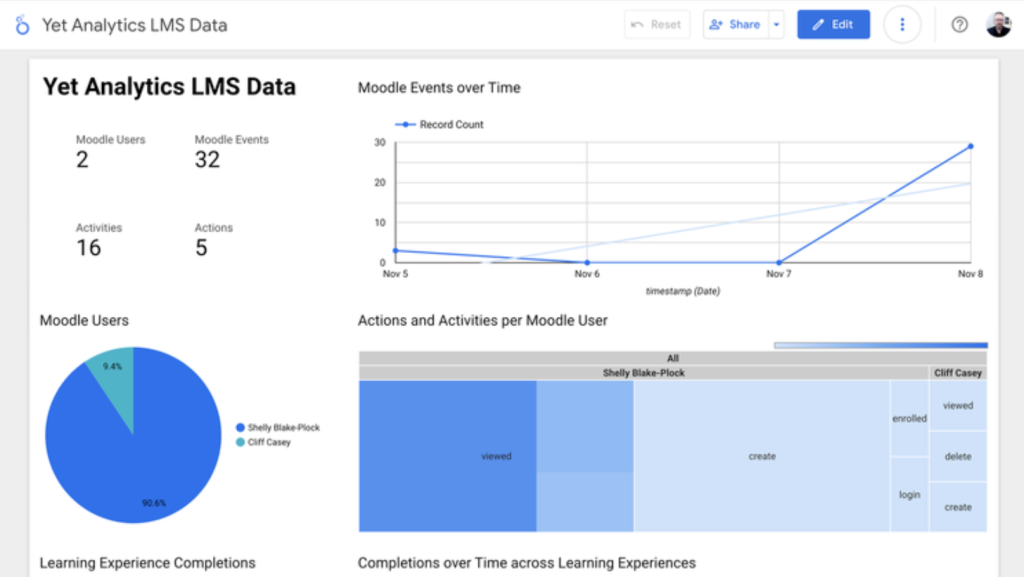
12. GrassBlade
GrassBlade is a versatile LRS designed to integrate seamlessly with popular LMS platforms such as WordPress and Moodle. It supports xAPI and SCORM, making it ideal for tracking diverse learning activities. GrassBlade is particularly favored for its user-friendly interface and flexibility, catering to organizations of all sizes.
Features:
- Compatibility with xAPI, SCORM, and Tin Can API.
- Integration with WordPress, Moodle, and other LMS platforms.
- Real-time data tracking and reporting.
- Flexible hosting options (cloud or self-hosted).
- Easy-to-navigate interface for administrators.
Comparison Table for Best LRS
| LRS Software | Integration Options | Analytics Capabilities | Scalability | Ideal For |
| Veracity Learning | LMS, HR systems, custom tools | Real-time tracking, reporting | High | Small to medium-sized organizations |
| Instancy | LMS, CMS, third-party tools | Basic reporting, dashboards | Moderate | Blended and mobile learning environments |
| ProProfs | LMS, quiz tools, online platforms | Reporting, learner tracking | Moderate | eLearning and assessment tracking |
| Xyleme | Authoring tools, LMS | Deep analytics, content reuse | High | Content-focused learning organizations |
| Sponge | Learning apps, LMS | Custom reporting dashboards | Moderate | Custom eLearning solutions |
| Rustici | LMS, HR systems | Data aggregation, reporting | High | Large enterprises with complex ecosystems |
| Watershed | LMS, BI tools, custom systems | Advanced analytics, dashboards | Very High | Enterprise-level organizations |
| Valamis | LMS, HR systems, enterprise tools | Predictive analytics, reporting | High | Workforce transformation and compliance |
| Learning Locker | LMS, authoring tools, custom APIs | Flexible reporting, dashboards | High | Open-source, cost-conscious organizations |
| OnPoint Digital | LMS, mobile learning platforms | Multi-platform data tracking | High | Mobile-first learning environments |
| Yet Analytics | LMS, BI tools | Visual analytics, dashboards | High | Data-driven decision-making |
| GrassBlade | WordPress, Moodle, LMS | Real-time tracking, reporting | High | LMS integration for smaller organizations |
What is the Difference Between LRS and LMS?
A Learning Record Store (LRS) and a Learning Management System (LMS) serve different purposes within a learning ecosystem.
An LMS focuses on delivering and managing structured learning programs, such as eLearning courses, certifications, and assessments. It provides tools for content creation, learner assignment, progress tracking, and reporting, primarily for formal training within the platform.
In contrast, an LRS is designed to collect, store, and analyze learning data from diverse sources, including informal learning, simulations, and real-world activities, using the xAPI standard.
Together, they complement each other to provide a holistic view of organizational learning and development.
Key Features to Look for in LRS Software
Here are some of the key features to look for in an LRS software.
- xAPI compliance: xAPI compliance is essential for an LRS as it enables the system to capture learning data from various sources, both formal and informal, ensuring comprehensive tracking of all learning activities.
- Data analytics and reporting: Robust analytics and reporting tools allow organizations to analyze learning behaviors, measure training effectiveness, and generate actionable insights to improve learning outcomes.
- Integration capabilities: An effective LRS should integrate seamlessly with Learning Management Systems (LMS), HR platforms, and other tools, creating a unified learning ecosystem that streamlines data sharing and reporting.
- Scalability: Scalability ensures the LRS can handle growing volumes of data and users as the organization expands, making it a sustainable solution for long-term learning initiatives.
- User-friendly interface: A simple and intuitive interface makes it easy for administrators to access, analyze, and utilize data without requiring extensive technical knowledge.
- Data security and privacy: Strong security features and compliance with regulations such as GDPR and HIPAA are critical to protect sensitive learner data and ensure organizational compliance with privacy standards.
Training Clicks Better With Whatfix
A relatively fresh eLearning technology, an LRS has one major benefit over older systems — it supports tracking across multiple devices and apps. By centralizing all the learning experience data in one place, an LRS will allow you to increase learner engagement and improve your eLearning ROI.
If you are looking to deliver new types of learning in engaging formats such as video, slideshows, and PDFs – all while empowering users to achieve proficiency in record time, implement Whatfix digital adoption platform and deliver personalized, on-demand training at scale.
To learn more about Whatfix, schedule a free demo with us today!
